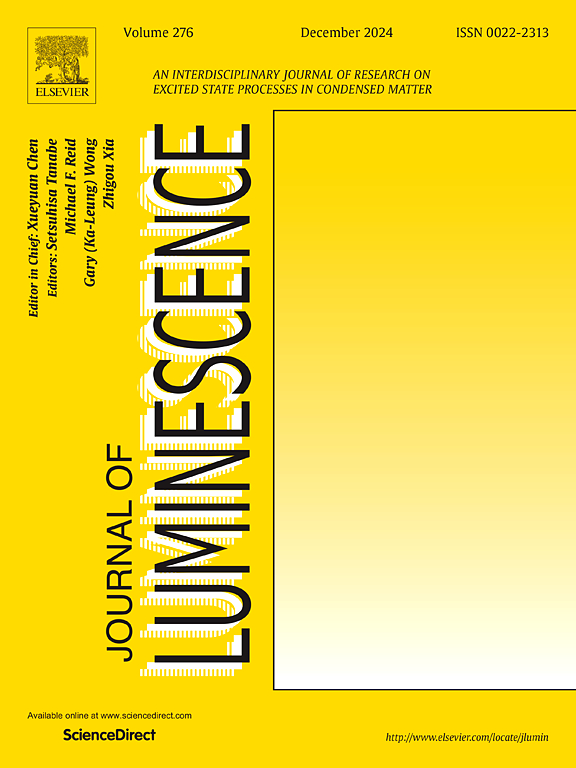利用Sr3La(VO4)3:Eu3+荧光粉实现三模光学测温
IF 3.3
3区 物理与天体物理
Q2 OPTICS
引用次数: 0
摘要
近年来,多模光学测温技术被认为是一种很有前途的精确测温技术。在这项工作中,成功地制备了一系列Sr3La1−x(VO4)3:xEu3+ (x = 0-0.10)样品。由于VO43−基团和Eu3+离子之间的能量转移,Sr3La1−x(VO4)3:xEu3+荧光粉在350 nm光激发下同步发射VO43−和Eu3+。随着温度的升高,VO43−和Eu3+的发光强度有不同程度的降低趋势。因此,设计了Sr3La1−x(VO4)3:xEu3+测温的荧光强度、荧光强度比和欧委会L’eclairage模式坐标。值得注意的是,它们的最大相对灵敏度(SR)分别高达2.93% K−1 @ 320 K, 2.65% K−1 @ 303 K和0.37% K−1 @ 357 K。在303 ~ 483 K的温度范围内,荧光强度和荧光强度比值模式的SR值均高于1.55% K−1和1.25% K−1。我们的研究结果表明,Sr3La1−x(VO4)3:xEu3+荧光粉在精确测量温度方面具有很好的应用前景。本文章由计算机程序翻译,如有差异,请以英文原文为准。

Achieving three-mode optical thermometry via Sr3La(VO4)3:Eu3+ phosphors
Multi-mode optical thermometry is recently regarded as a promising technique for accurate temperature measurement. In this work, a series of Sr3La1−x(VO4)3:xEu3+ (x = 0–0.10) samples was successfully prepared. Owing to the energy transfer between VO43− groups and Eu3+ ions, Sr3La1−x(VO4)3:xEu3+ phosphors emit emissions from VO43− and Eu3+ synchronously upon excitation with 350 nm light. And the luminescent intensities of VO43− and Eu3+ have different decreasing tendencies as temperature increases. Therefore, fluorescence intensity, fluorescence intensity ratio, and coordinates of Commission Internationale de L'Eclairage modes of Sr3La1−x(VO4)3:xEu3+ thermometry were designed. Notably, their maximum relative sensitivities (SR) reach as high as 2.93 %K−1 @ 320 K, 2.65 %K−1 @ 303 K, and 0.37 %K−1 @ 357 K, respectively. Moreover, SR values of fluorescence intensity and fluorescence intensity ratio modes maintain higher than 1.55 %K−1 and 1.25 %K−1 at temperature range of 303–483 K. Our findings show that Sr3La1−x(VO4)3:xEu3+ phosphors have promising applications for accurate temperature measurement.
求助全文
通过发布文献求助,成功后即可免费获取论文全文。
去求助
来源期刊

Journal of Luminescence
物理-光学
CiteScore
6.70
自引率
13.90%
发文量
850
审稿时长
3.8 months
期刊介绍:
The purpose of the Journal of Luminescence is to provide a means of communication between scientists in different disciplines who share a common interest in the electronic excited states of molecular, ionic and covalent systems, whether crystalline, amorphous, or liquid.
We invite original papers and reviews on such subjects as: exciton and polariton dynamics, dynamics of localized excited states, energy and charge transport in ordered and disordered systems, radiative and non-radiative recombination, relaxation processes, vibronic interactions in electronic excited states, photochemistry in condensed systems, excited state resonance, double resonance, spin dynamics, selective excitation spectroscopy, hole burning, coherent processes in excited states, (e.g. coherent optical transients, photon echoes, transient gratings), multiphoton processes, optical bistability, photochromism, and new techniques for the study of excited states. This list is not intended to be exhaustive. Papers in the traditional areas of optical spectroscopy (absorption, MCD, luminescence, Raman scattering) are welcome. Papers on applications (phosphors, scintillators, electro- and cathodo-luminescence, radiography, bioimaging, solar energy, energy conversion, etc.) are also welcome if they present results of scientific, rather than only technological interest. However, papers containing purely theoretical results, not related to phenomena in the excited states, as well as papers using luminescence spectroscopy to perform routine analytical chemistry or biochemistry procedures, are outside the scope of the journal. Some exceptions will be possible at the discretion of the editors.
 求助内容:
求助内容: 应助结果提醒方式:
应助结果提醒方式:


